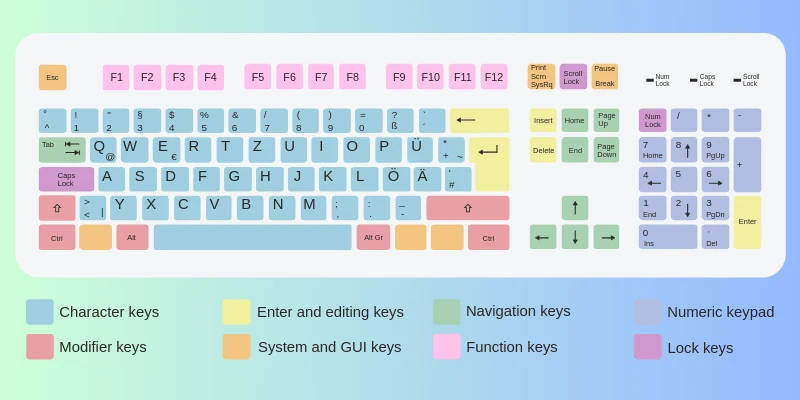Difference between Dvorak vs Qwertz that you should know
Published: 26 May 2025
The Dvorak Layout vs Qwertz Layout comparison highlights two distinct keyboard designs that serve very different purposes. While Dvorak was created to improve typing efficiency and ergonomics in English, Qwertz was adapted to accommodate German-language typists with region-specific characters. Understanding how these layouts differ can help you choose the right one for speed, comfort, or language needs. Let’s explore difference between Dvorak vs Qwertz Layout in detail.
1. Dvorak Layout
The Dvorak Simplified Keyboard was invented in the 1930s by Dr. August Dvorak and his brother-in-law, Dr. William Dealey. Dissatisfied with the inefficiencies of the dominant QWERTY layout, which was originally designed in the 19th century for mechanical typewriters to reduce key jams, Dvorak set out to create a keyboard optimized for modern typing needs.
The core philosophy behind Dvorak was to minimize finger movement, increase typing speed, and reduce fatigue by placing the most frequently used letters under the strongest fingers and on the home row, the row where fingers naturally rest. Letters were arranged to promote hand alternation, reducing the strain caused by repetitive finger motion on the same hand.
Although the Dvorak layout showed promise in lab tests and among enthusiasts, it never overtook QWERTY’s dominance largely due to the inertia of existing infrastructure and user familiarity.

2. Qwertz Layout
Unlike Dvorak, the Qwertz layout is not a radical redesign but a regional adaptation of the QWERTY layout tailored for German-speaking countries such as Germany, Austria, and Switzerland. It emerged to accommodate the specific needs of the German language, which includes letters and diacritics not present in English.
The most noticeable difference is the swapping of the “Y” and “Z” keys, hence the name “Qwertz” instead of “Qwerty.” This change reflects the frequency and importance of the letter “Z” in German, which is much higher than in English. Additionally, Qwertz keyboards include keys for umlauts (ä, ö, ü) and the Eszett (ß), which are essential in German.

3. Keyboard Layout Design and Ergonomics
Dvorak Layout
The Dvorak layout is methodically designed around the frequency of letter use in English. Some key ergonomic considerations include:
- Home Row Dominance: About 70% of all keystrokes occur on the home row, compared to only around 32% in QWERTY. This means your fingers move less, which reduces fatigue.
- Strong Fingers Usage: The strongest fingers (index and middle) handle the most frequent letters, while the weaker ones (ring and pinky) deal with less common letters.
- Hand Alternation: Dvorak encourages alternating hands while typing, which can increase speed and decrease strain.
- Minimized Same-Finger Repetition: It reduces consecutive use of the same finger, which can cause stress injuries.
These design principles aim to create a more comfortable typing experience, especially beneficial for people who type extensively for work or leisure.
Qwertz Layout
Qwertz retains much of QWERTY’s design, including some of its ergonomic limitations:
- Home Row Utilization: Qwertz is similar to QWERTY in placing many common letters away from the home row, resulting in more finger movement.
- Letter Placement: The swap of “Y” and “Z” reflects the linguistic needs of German but doesn’t alter the overall key arrangement significantly.
- Special Characters: Qwertz includes keys for umlauts and Eszett, which are vital for accurate German typing.
- Punctuation: Some punctuation marks are relocated compared to QWERTY, which can cause minor adaptation challenges.
While not designed specifically for ergonomic optimization, Qwertz balances familiarity with necessary regional adaptations.
4. Language Support and Usage
Dvorak Layout
Dvorak’s letter frequency optimization is based on English letter use. While this makes it very efficient for English typing, it limits its practical application in other languages, especially those with special characters or diacritics not accounted for in the layout.
For example, typing in German, French, or other languages with accented letters on a Dvorak layout can be cumbersome unless users customize the layout further. This restricts Dvorak’s global adoption despite its ergonomic benefits.
Qwertz layout
Qwertz is designed explicitly for German and other Central European languages like Czech and Slovak. Its inclusion of umlauts (ä, ö, ü) and the Eszett (ß) directly on the keyboard makes typing in these languages far more efficient and natural.
While it doesn’t improve ergonomics dramatically over QWERTY, it facilitates accurate language representation and proper spelling. For native speakers, this makes Qwertz an almost mandatory choice.
5. Learning Curve and Adoption
Dvorak Layout
Adopting the Dvorak layout requires a significant initial investment in learning and practice. Since most users are trained on QWERTY or its variants, switching to Dvorak can temporarily reduce typing speed and accuracy.
- Transition Time: Users often experience a drop in productivity initially, which can last from days to weeks.
- Support: Most modern operating systems support Dvorak, making the switch technically feasible without additional hardware.
- Community: A smaller but passionate community promotes the Dvorak layout, and some professional typists swear by it.
For those willing to persevere, many report faster typing speeds and less fatigue in the long run.
Qwertz Layout
If you are already familiar with QWERTY, switching to Qwertz is usually straightforward, especially if you type in German or related languages.
- Minor Key Changes: The main difference, the swapped “Y” and “Z” keys, may cause momentary confusion.
- Special Characters: Umlauts and Eszett keys are new but necessary, so users typically adapt quickly.
- Widespread Use: Because Qwertz is the standard in German-speaking countries, hardware, software, and training materials are readily available.
For users in its target region, Qwertz is essentially the default.
6. Practical Pros and Cons
| Feature | Dvorak Layout | Qwertz Layout |
|---|---|---|
| Typing Efficiency | Potentially faster with reduced finger movement | Similar to QWERTY; not optimized for speed |
| Ergonomics | Designed to reduce strain and finger fatigue | No special ergonomic advantage over QWERTY |
| Language Support | Optimized for English only; poor support for others | Excellent for German and Central European languages |
| Learning Curve | Steep initial learning curve; requires commitment | Minimal; easy for QWERTY users to adapt |
| Popularity | Niche; favored by enthusiasts and typists | Main layout in German-speaking countries |
| Special Characters | Limited support for accented letters and symbols | Includes umlauts and Eszett |
| Hardware Availability | Generally uses standard keyboards; no special hardware | Standard keyboards widely available |
| Software Support | Supported by most OS but sometimes requires manual switching | Default in German OS installations |
7. Real-World Use Cases
Who Should Consider Dvorak?
- English Language Writers and Coders: People who type extensively in English and want to reduce strain or increase speed.
- Ergonomics Enthusiasts: Those prone to repetitive strain injuries may find Dvorak’s design helpful.
- Keyboard Hobbyists: Individuals interested in exploring alternative typing methods.
Who Should Stick with Qwertz?
- German Speakers: Essential for proper character input and efficient typing.
- Casual and Professional Typists in Central Europe: Because of regional standards.
- Users Requiring Familiarity: Those who cannot afford a lengthy learning period.
8. Can You Switch Between Them?
Most modern computers allow easy switching between keyboard layouts through software settings. For multilingual users or those curious about alternatives, this flexibility can help explore layouts without hardware changes. However, physically labeled keyboards usually only represent one layout, which can cause confusion.
Yes, it takes time and practice. Most people need a few weeks to get comfortable and a few months to regain full typing speed. But many who stick with it say it feels more natural and reduces hand strain.
Because in German, the letter “Z” is used more often than “Y”. Qwertz rearranges these keys to match that frequency. This makes typing in German faster and more intuitive.
Yes! You can switch layouts in your computer’s settings, no new hardware needed. Just keep in mind the physical keys may not match the new layout unless you relabel or memorize them.
Potentially, yes, especially for English typists. Dvorak is designed to reduce finger movement, which can increase speed over time. But results vary depending on how much you practice.
Qwertz is best for typing in German. It includes keys for umlauts (ä, ö, ü) and the Eszett (ß), which are essential in German. Dvorak doesn’t support these characters natively.
Many users report less strain and fatigue with Dvorak due to its ergonomic design. It reduces finger movement and avoids overusing the same hand. While not a medical fix, it may help prevent or reduce symptoms.
Yes, there are versions for left-handed, right-handed, and international users. Some are also modified for programming. The standard version is optimized for general English typing.
You can set up multiple layouts and switch between them easily in your system settings. However, this can slow you down if you’re constantly switching. Choose the one you use most often as your primary layout.
If you type a lot in English and want better comfort or speed, it might be. But it depends on your goals, Qwerty and Qwertz are still more common. Dvorak is a good choice if you’re willing to invest time into learning.
Most smartphones allow you to change the keyboard layout in settings or through apps. Dvorak support is less common than Qwertz, but still possible. Just be aware that it may feel different on a touchscreen.
Conclusion
So guys, in this article, we’ve covered Dvorak Layout vs Qwertz Layout in detail. Personally, I believe if you’re an English-speaking typist looking for long-term comfort and faster typing, the Dvorak layout is worth the learning curve. However, if you regularly type in German or any Central European language, Qwertz is clearly the more practical choice. Ultimately, the best layout is the one that fits your daily needs. Try experimenting with both and see what feels right, your hands will thank you. Let me know in the comments which layout you prefer, or if you’re considering switching!

- Be Respectful
- Stay Relevant
- Stay Positive
- True Feedback
- Encourage Discussion
- Avoid Spamming
- No Fake News
- Don't Copy-Paste
- No Personal Attacks

- Be Respectful
- Stay Relevant
- Stay Positive
- True Feedback
- Encourage Discussion
- Avoid Spamming
- No Fake News
- Don't Copy-Paste
- No Personal Attacks
